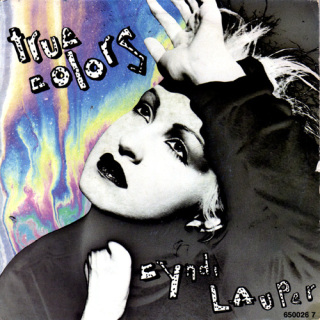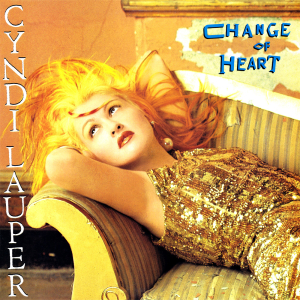
Cynthia Ann Stephanie Lauper is an American singer, songwriter, actress, and activist. Her career has spanned over 40 years. Her album She's So Unusual (1983) was the first debut album by a female artist to achieve four top-five hits on the Billboard Hot 100—"Girls Just Want to Have Fun", "Time After Time", "She Bop", and "All Through the Night"—and earned Lauper the Best New Artist award at the 27th Annual Grammy Awards in 1985. Her success continued with the soundtrack for the motion picture The Goonies (1985) and her second record True Colors (1986). This album included the number-one single "True Colors" and "Change of Heart", which peaked at number three. In 1989, Lauper saw success with "I Drove All Night" and in 1993, had her first dance club hit with "That's What I Think".

She's So Unusual is the debut studio album by American singer and songwriter Cyndi Lauper, released on October 14, 1983, by Portrait Records. The album was re-released in 2014 to commemorate its 30th anniversary, and was called She's So Unusual: A 30th Anniversary Celebration. The re-release contains demos and remixes of previously released material, as well as new artwork.

"Girls Just Want to Have Fun" is a song made famous by American singer-songwriter Cyndi Lauper four years after it was written by Robert Hazard. It was released by Portrait Records as Lauper's first major single as a solo artist and the lead single from her debut studio album, She's So Unusual (1983). Lauper's version gained recognition as a feminist anthem and was promoted by a Grammy-winning music video. It has been covered, either as a studio recording or in a live performance, by over 30 other artists.
"I Drove All Night" is a song written and composed by American songwriters Billy Steinberg and Tom Kelly and originally intended for Roy Orbison. Orbison recorded the song in 1987, the year before his death, but his version was not released until 1992. Cyndi Lauper recorded the song and released it as a single for her A Night to Remember album. Her version became a top 10 hit on both sides of the Atlantic in 1989 and was also her final top 40 hit on the American pop charts. Lauper still regularly performs the song in her live concerts. The song has also been covered by Canadian singer Celine Dion, whose version topped the Canadian Singles Chart and reached number 7 on the US Adult Contemporary chart in 2003.

"MMMBop" is a song written and performed by American pop rock band Hanson. It was released on April 15, 1997, as the lead single from their first full-length studio album, Middle of Nowhere (1997). The song was nominated for two Grammys at the 40th Annual Grammy Awards and is the band's most successful single to date. "MMMBop" was a major success worldwide, reaching number one in at least 12 countries, including Australia, Canada, Germany, New Zealand, the United Kingdom and the United States.

Twelve Deadly Cyns...and Then Some is a greatest hits album by American singer Cyndi Lauper, released on August 22, 1994, through Epic Records. It contains a collection of singles from the singer's first four studio albums. It also contains three new songs: "(Hey Now) Girls Just Want to Have Fun", "I'm Gonna Be Strong" and "Come On Home", all of which were released as singles. To promote the record, the singer embarked on a worldwide tour. A video album was simultaneously released and contained music videos of fourteen songs.

"What's Going On" is a song by American singer-songwriter Marvin Gaye, released in 1971 on the Motown subsidiary Tamla. It is the opening track of Gaye's studio album of the same name. Originally inspired by a police brutality incident witnessed by Renaldo "Obie" Benson, the song was composed by Benson, Al Cleveland, and Gaye and produced by Gaye himself. The song marked Gaye's departure from the Motown Sound towards more personal material. Later topping the Hot Soul Singles chart for five weeks and crossing over to number two on the Billboard Hot 100, it would sell over two million copies, becoming Gaye's second-most successful Motown song to date. It was ranked at number 4 in Rolling Stone's 500 Greatest Songs of all Time in 2004 and 2010.

"Time After Time" is a 1983 song by American singer-songwriter Cyndi Lauper, co-written with Rob Hyman, who also provided backing vocals. It was the second single released from her debut studio album, She's So Unusual (1983). The track was produced by Rick Chertoff and released as a single in March 1984. The song became Lauper's first number 1 hit in the U.S. The song was written in the album's final stages, after "Girls Just Wanna Have Fun", "She Bop" and "All Through the Night" had been written or recorded. The writing began with the title, which Lauper had seen in TV Guide magazine, referring to the science fiction film Time After Time (1979).
"I'm Gonna Be Strong" is a song written by the songwriting duo Barry Mann and Cynthia Weil. It was first recorded by Frankie Laine in 1963 and released as a single on Columbia Records. However, the song did not become a major hit until 1964, when Gene Pitney released his version as a single. It was also a single released by the 1980 band Blue Angel, with lead vocals provided by future star Cyndi Lauper. This release was prior to Lauper's solo career; however, Lauper re-recorded the track and released it as a single in 1994. The song was also featured on 1982's Quiet Lies album by Grammy winner Juice Newton. Though Newton never released the song as a single, her remake was later added as a bonus track to her first Greatest Hits collection.

"Money Changes Everything" is a song by American rock band the Brains from their eponymous debut studio album (1980). Originally released in 1978, the song was reissued as the lead single from the album in 1980, by Mercury Records. Frontman Tom Gray is credited as the sole writer of the song, while production was collectively helmed by the Brains and Bruce Baxter. The song was popularized in 1984 by Cyndi Lauper, who released a cover version of the song as a single from her debut studio album, She's So Unusual (1983).

"True Colors" is a song written by American songwriters Billy Steinberg and Tom Kelly. It was both the title track and the first single released from American singer Cyndi Lauper's second studio album of the same name (1986). Released in mid-1986, the song would become a hit for Lauper, spending two weeks at number one on the US Billboard Hot 100, becoming her last single to occupy the top of the chart. It received a Grammy Award nomination for Best Female Pop Vocal Performance.

"Change of Heart" is a song by American singer and songwriter Cyndi Lauper, released on November 11, 1986 as the second single from her second album, True Colors (1986). It went gold in the US, peaking at No. 3 on the Billboard Hot 100. The song was written by singer-songwriter Essra Mohawk. Popular remixes by Shep Pettibone were also released. A music video was produced for the song, filmed in Trafalgar Square in London. It features Lauper and her tour band performing the song in front of a large group of people. The Bangles sang background vocals on the original recording. A live version of the song was released on Lauper's live album/DVD, To Memphis, with Love.

"Typical Male" is a song recorded by American singer Tina Turner. It was written by Terry Britten and Graham Lyle and produced by the former for Turner's studio album Break Every Rule (1986).

"Stay" is a doo-wop song written by Maurice Williams and first recorded in 1960 by Williams with his group the Zodiacs. Commercially successful versions were later also issued by the Hollies, the Four Seasons and Jackson Browne.

American singer Cyndi Lauper has released eleven studio albums, six compilation albums, five video albums and fifty-three singles. Worldwide, Lauper has sold approximately 50 million albums, singles and DVDs. According to RIAA, She has sold 8.5 million certified albums in the United States with She's so Unusual being her biggest seller.

"Walk On By" is a song written by Burt Bacharach and Hal David for singer Dionne Warwick in 1963. The song peaked at number 6 on the US Billboard Hot 100 and number 1 on the Cash Box Rhythm and Blues Chart In June 1964 and was nominated for a 1965 Grammy Award for the Best Rhythm and Blues Recording.
"All Through the Night" is a song written and recorded by Jules Shear for his 1983 album Watch Dog. It was produced by Todd Rundgren.

"Disco Inferno" is a song by American disco band the Trammps from their 1976 fourth studio album of the same name. With two other cuts by the group, it reached No. 1 on the US Billboard Dance Club Songs chart in early 1977, but had limited mainstream success until 1978, after being included on the soundtrack to the 1977 film Saturday Night Fever, when a re-release hit number eleven on the Billboard Hot 100 chart.

"Stuck with You" is a song by American rock band Huey Lewis and the News, written by guitarist Chris Hayes and lead singer Huey Lewis. Released in 1986, it was the first single from the band's fourth album, Fore!. The song spent three weeks at number one on the US Billboard Hot 100, becoming the band's second number-one hit on the chart. Internationally, the song became the band's second top-20 hit in the United Kingdom, reaching number 12 on the UK Singles Chart, and peaked within the top 10 in Australia, Canada, Iceland, South Africa, and New Zealand.















